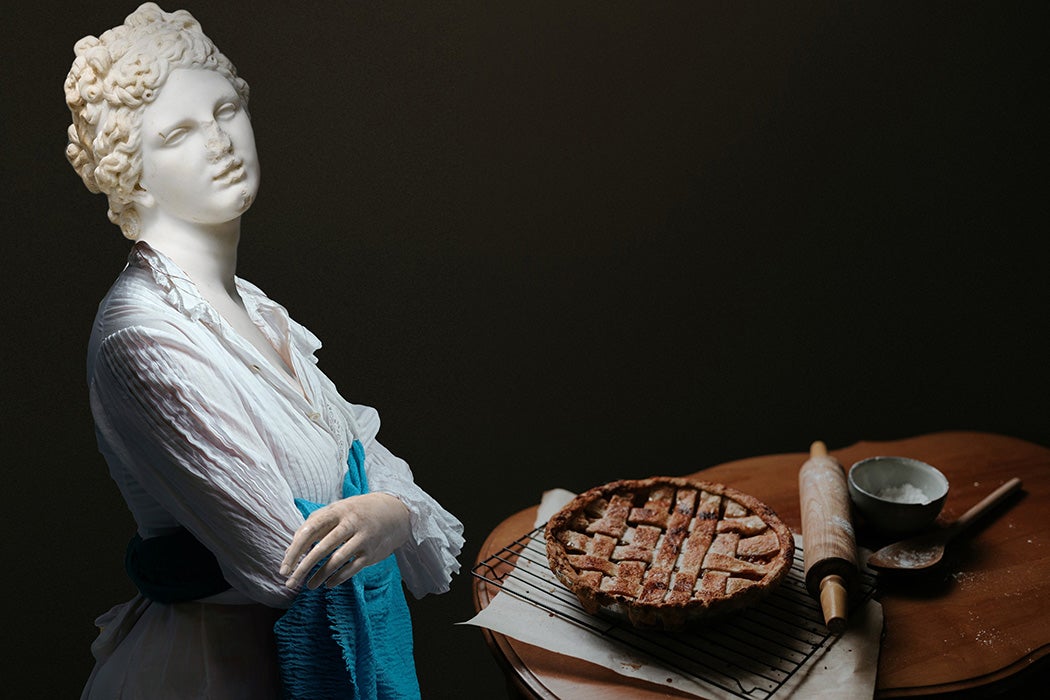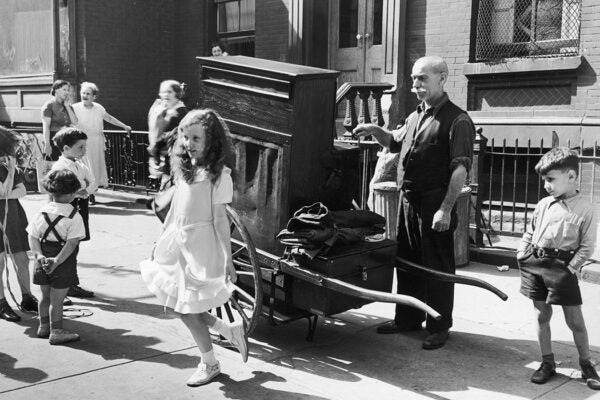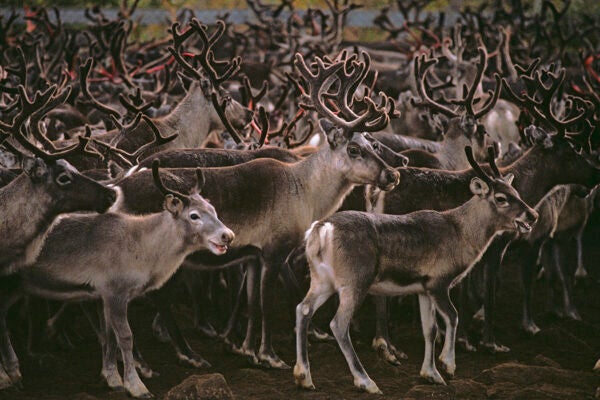If there’s a style that defines 2020, it has to be “cottagecore.” In March 2020, the New York Times defined it as a “budding aesthetic movement… where tropes of rural self-sufficiency converge with dainty décor to create an exceptionally twee distillation of pastoral existence.” In August, consumer-culture publication The Goods by Vox heralded cottagecore as “the aesthetic where quarantine is romantic instead of terrifying.”
Baking, one of the activities the quarantined population favored at the height of the pandemic, is a staple of cottagecore, whose Instagram hashtag features detailed depictions of home-baked goods. Moreover, the designer Lirika Matoshi’s Strawberry Dress, defined as The Dress of 2020, fully fits into the cottagecore aesthetic. A movement rooted in self-soothing through exposure to nature and land, it proved to be the antidote to the stress of the 2020 pandemic for many.
Weekly Newsletter
Despite its invocations of rural and pastoral landscapes, the cottagecore aesthetic is, ultimately, aspirational. While publications covering trends do point out that cottagecore is not new—some locate its origins in 2019, others in 2017—in truth, people have sought to create an escapist and aspirational paradise in the woods or fields for 2,300 years.
Memories of Arcadia
Ancient Greece had an enduring fascination with the region of Arcadia, located in the Peloponnesus, which many ancient Greeks first dismissed as a primitive place. After all, Arcadia was far from the refined civilization of Athens. Arcadians were portrayed as hunters, gatherers, and sensualists living in an inclement landscape. In the Hellenistic age, however, Arcadia became an idea in the popular consciousness more than a geographical place.
Alexandria, founded by Alexander the Great, had become a metropolis of more than a million people. The city was filthy, polluted, and ridden with disease. Its citizens developed what we can now call nostalgia for simpler times. They turned to Arcadia, which came to represent both an untainted, yet benign countryside and the spiritual haven of a simple life.
The Sicilian-born poet Theocritus (316–260 BCE), widely credited as the inventor of pastoral poetry, gave form to this longing for a return to the simple life. He wrote many Idylls, where shepherds and shepherdesses frolicked in nature and engaged in poetic and song contests. Theocritus raised shepherds and country people above their social and cultural status: they speak sophisticatedly, and they spontaneously engage in poetry contests. The target audience for this poetry, however, was the educated urban class who wanted to escape to the countryside while preserving their own refinement: “Theocritus’ shepherds (who seem to spend more time in pleasant conversation and lively love song contests, lying lazily during the resting hour on the grass by a river or spring, under shady trees, than in tending their flocks) move in an atmosphere of peace, quiet and happiness that is far removed from the harsh reality of pastoral life in all times and places,” write the scholars J. Vara and Joanna Weatherby in Mnemosyne.

The Latin poet Virgil (70-19 BCE) expanded the reach of the pastoral genre. A native of Northern Italy, then known as Gallia Cisalpina, Virgil came from a family of modest land-owners. His family’s beloved land was re-allotted into 60 settlements for soldiers in the struggle that broke out in the aftermath of Julius Caesar’s death. These events provoked in Virgil a desire to escape from the chaos, violence, and disorder of war, into the serenity and peace of an Arcadian dream, and the theme permeates his pastoral poetry. Yet the outside world does penetrate his fabled countryside. In his first major work, the Eclogues, Virgil acknowledges the passing of seasons. The first Eclogue, for example, features two bantering shepherds, Tityrus and Meliboeus, in a standard idealized landscape. Both have lost their land, and while Tityrus’s possessions have been restored by the “gay, young prince of Rome,” Meliboeus is forced to leave. Virgil’s pastoralism thus served a means to explore contemporary issues, moral and political, without directly engaging with them, a trope that would define pastoralism through the centuries.
Pure escapist pastoral landscape persisted in the form of novels, romance-like narratives set in fantastic settings, aimed at a courtly audience in the Roman Empire. One of these was Daphnis and Chloe by Longus (second century CE) which sees a shepherd and shepherdess gradually fall in love, but have to overcome myriads of obstacles before being able to marry. The plot twist is that they are actually aristocrats.
The Pastoral Element in the Renaissance
St. Augustine (fourth century CE) argued that Adam’s sin had brought about moral corruption, not only in man, but throughout the whole of nature. In Augustine’s imagining, nature is hostile to mankind, if not downright satanic, and the sensual and bountiful pastoral landscape a testimony of the frail nature of humankind.
We can credit the Italian poet Petrarch (1304-1374) for restoring the pastoral landscape across the arts. From his home base in Vaucluse (now known as Fontaine-de-Vaucluse), near Avignon, he delighted in exploring the nearby countryside, and, famously, climbed to the top of Mont Ventoux for pleasure. He was eventually overcome with guilt, torn between his sensual love of nature and his Augustine-centric intellectual imprint. He managed, however, to integrate the pastoral into his poetry. Just as Virgil used the pastoral to reflect on the tensions of Rome at the cusp of becoming an empire, Petrarch enthusiastically adopted it as a metaphor for the condition of the intellectual, humanist scholar and poet in the middle of the fourteenth century.
His Bucolicum Carmen, which consists of 12 eclogues, reflects on the realities of the era. In particular, the sixth and seventh eclogues feature shepherds that act as stand-ins for the Pope and the Church, exposing their corruption. Petrarch is also known for his gardens: he built one whenever he went. Petrarch described his modest property at Vaucluse as his “transalpine Helicon,” a reference to the birthplace of the Muses: He envisioned the space as a place of learning and poetry, closely associated with the teachings of Virgil. Renaissance poets and artists in Italy enthusiastically embraced pastoral landscapes in all art forms, and, in 1690, the name “Arcadia” was given to the literary academy that was set out to purge Italian literature of all the flowery artifice of the baroque.
But it was in Elizabethan England that the pastoral genre really became in vogue. Shakespeare has two pastoral plays, As You Like It and A Winter’s Tale, whose source material includes the tale of Daphnis and Chloe. As You Like It contains a debate between pastoral and anti-pastoral: one character, the jester Touchstone, feels better at court, while he looks down on country people, while the shepherd Corin defends his own lifestyle. It’s actually not clear who wins the debate. What’s more, Shakespeare’s plays, including As You Like It and A Winter’s Tale, feature aristocrats play-acting being shepherds and falling in love with shepherdesses, but only marry them when they find out that said shepherdesses are abandoned royalty themselves.
Christopher Marlowe’s “The Passionate Shepherd to his Love,” is one of the best-known examples of English Renaissance pastoral poetry, with a shepherd inviting his beloved to enjoy a romp in his own version of Arcadia, a vision of eternal spring. It inspired poetic replies from other poets, from John Donne to Dorothy Parker. Quite tellingly, the most famous reply comes from sir Walter Raleigh (1554-1618), who had the shepherd’s beloved rebuke him, uttering words such as:
Thy gowns, thy shoes, thy beds of roses
Thy cap, thy kirtle, and thy posies
Soon break, soon wither, soon forgotten: In folly ripe, in reason rotten.
She points out, in other words, that the idea of Arcadia is rooted in fallacy.
Pastoral poetry, while detached and elitist in theme and style, is still marked by a sense of community, which is expressed through the form of invitation. “The invitation demonstrates that the pastoral landscape has something to offer, whether it is a rustic feast, country entertainments, or simply a homely cottage in which to rest for the night,” writes the literary scholar Kimberly Huth in Studies in Philology. Huth examines the spoken act of invitation in the context of early modern pastoral poetry, writing:
It acts as the first step in extending that community to others who may be passing through the pastoral world by offering not only a comfortable place to rest but also fellowship and belonging. The pastoral landscape is often imagined as an ideal world of respite from corruption of the court or city, but it is actually the invitation that creates the ideality of that world, which is only recognizable through interactions with other people in the landscape.
Cottagecore too has a strong community aspect, even if its invitations are mostly digital.
The Case of Marie Antoinette
When it comes to the 360-degree-open-lifestyle discourse revolving around cottagecore, the most eminent antecedent is Marie Antoinette, who reigned in France from 1774 to 1792. While her standing as a monarch has been the subject of endless gossip, discussion, artwork, and morbid fascination, it’s not a stretch to say that, fashion-wise, Marie Antoinette was revolutionary.
The portrait of Marie Antoinette by her favorite portraitist (and perhaps lover) Elizabeth Vigee Le Brun, which was presented in 1783, depicts her without the accoutrements of royal portraiture: no regal ermine cape, jewelry, elaborate hairdo, and high-contrast makeup. In this painting, the queen wears nothing but a wide-brimmed straw hat, and a muslin gaulle (loose gown) fastened with a wide sash of gauze. Only the roses that she holds in her hand are a reminder of her house of Habsburg. Otherwise, nothing in the painting is an indicator of royalty. In the news covering the exhibition, the portrait described the queen as being “dressed up like a serving maid” and “wearing the chamber-maid’s dust-cloth.” The gaulle Marie Antoinette sported is indistinguishable from a chemise, an item of underwear, so in this painting, the queen looked both undignified and indecent.

The same year the portrait was unveiled, she had an entire hameau (rustic village) built as a place of leisure: it comprised meadows, lakes, grottos, streams, a dovecote, a dairy, cottages, vineyards, fields, orchards, vegetable gardens, and pagan temples. It was a fully-operational farm, where the queen would host social events. She and her entourage would “cosplay” as farmers and shepherdesses. “The Hameau was considered a type of ferme ornée or ornamented farm that combined agricultural production or utility with pleasures for the eyes and other bodily senses,” writes the scholar of visual culture Jill H. Casid.
Casid explores the camp and performative nature of Marie Antoinette’s peasant reverie. She continues:
[The Hameau] is most notoriously the location of the historic joke of Marie-Antoinette playing the milkmaid. Beginning with gossip at court as the Hameau was being built (1783-86), the critical figuration of the Hameau as a stage set, a playground for performing the dairywoman or fermière, functioned to do the labor of distinguishing reputedly natural virtue from its ostensibly corrupt simulation. The Marquis de Bombelles’ Journal entry (12 December 1783), recounting his view of the Hameau de la Reine as it was being built, focuses particularly on the class transvestism of the cottages, designed to give the appearance of age.
Sneers aside, there are portraits of aristocrats from all over Europe proudly sporting the gaulle or chemise à la reine. The Baron de Frénilly called Marie Antoinette’s fashion legacy “revolution in linen.” The Museum of English Rural Life deems her a cottagecore icon. What’s more, the queer subtexts of Marie Antoinette’s Hameau phase, which are explained at length in Casid’s article, are very much present in the modern cottagecore aesthetic, which has a strong LGBTQ following. And the pricetags for 2020 cottagecore fashions are fit for a royal: see the $400-and-up linen dresses, $490 tulle dresses, $125 nightgowns, and the $400-and-up prairie dresses.
Mutable Pastoral
The idealized pastoral tableaux come to an end at the beginning of the nineteenth century. The yearning for the sublime supplants the search for solace. Still, the genre did not die out: Wordsworth, a nature poet, wrote the pastoral poem “Michael,” (1800) which tells the story of the aging shepherd Michael and his wayward son Luke. It’s imbued with bitterness, and we see that Michael is a “real” world-weary shepherd, as opposed to the merry country-folks of Theocritus and Marlowe.
Thomas Hardy’s Tess of the d’Urbervilles (1891) is markedly anti-pastoral despite its predominantly Arcadian setting. Far from being a place of respite from the ills of the world, his Arcadia is full of misery. Early in the novel, Tess is raped in that very Arcadian setting, and when she retreats with her beloved Angel, the son of university-educated clergy who dreams of farm life, to the Arcadian-like setting of Talbothays to escape the problems of modern life, things don’t go as planned. “It becomes apparent that pastoral literature is inherently problematic and destructive, regardless of whether it is written in ancient Greece or Victorian England,” writes the Hardy scholar Ryan Crennen for The Thomas Hardy Society. “In Tess he shows that nostalgia for Arcadia is a tragic dream, and he accomplishes this by subtly and allusively parodying the pastoral structure of retreat, renewal and return.”
Angel actively play-acts as a shepherd. “His fondness for the harp and animal husbandry are not accidental manifestations of the pastoral; rather, they are part of a concerted effort to manufacture a pastoral lifestyle for himself,” Crennen continues. In music, the pastoral symphonic poem Prelude to the Afternoon of a Faun by Claude Debussy (1894), which narrates a fawn’s romp, was deemed the “beginning of modern music” for its usage of modes and harmonies. Ralph Vaughan Williams’ Third Symphony (1922) is known as the Pastoral Symphony. Rather than a merry celebration of the pastoral landscape (à la Beethoven’s sixth), it’s an elegy for the fallen during World War I, a meditation on the trenches being in close proximity to a beautiful countryside.
In Virgil’s fifth Eclogue, the shepherds find a tombstone that reads “Et in Arcadia Ego,” which means “I am even in Arcadia,” with the I being death. The lines are a memento mori that tell us that, as fabled and as removed from everyday life a setting might be, reality and sociopolitical events eventually breach it. The same is true of cottagecore: while it developed partly in reaction to capitalism and urban corruption, homophobia, and transphobia, it has not been immune to capitalism-friendly commercialization (see the “peasant dresses that retail for hundreds of dollars), making it a mainstream component of contemporary popculture. The pastoral and cottagecore remain, first and foremost, an aspirational lifestyle, whose accoutrements require a considerable investment of money or, at least, time, for the sake of social-media performances.







